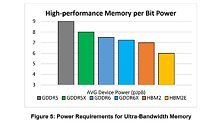
Micron Confirms Next-Gen NVIDIA Ampere Memory Specifications - 12 GB GDDR6X, 1 TB/s Bandwidth
Micron have spilled the beans on at least some specifications for NVIDIA's next-gen Ampere graphics cards. In a new tech brief posted by the company earlier this week, hidden away behind Micron's market outlook, strategy and positioning, lie some secrets NVIDIA might not be too keen to see divulged before their #theultimatecountdown event.
Under a comparison on ultra bandwidth solutions, segregated into the GDDR6X column, Micron lists a next-gen NVIDIA card under the "RTX 3090" product name. According to the spec sheet, this card features a total memory capacity of 12 GB GDDR6X, achieved through 12 memory chips with a 384-bit wide memory bus. As we saw today, only 11 of these seem to be populated on the RTX 3090, which, when paired with specifications for the GDDR6X memory chips being capable of 19-21 Gbps speeds, brings total memory subsystem bandwidth towards the 912 - 1008 GB/s range (using 12 chips; 11 chips results in 836 GB/s minimum). It's possible the RTX 3090 product name isn't an official NVIDIA product, but rather a Micron-guessed possibility, so don't look at it as factual representation of an upcoming graphics card. One other interesting aspect from the tech brief is that Micron expects their GDDR6X technology to enable 16 Gb (or 2 GB) density chips with 24 Gbps bandwidth, as early as 2021. You can read over the tech brief - which mentions NVIDIA by name as a development partner for GDDR6X - by following the source link and clicking on the "The Demand for Ultra-Bandwidth Solutions" document.
Under a comparison on ultra bandwidth solutions, segregated into the GDDR6X column, Micron lists a next-gen NVIDIA card under the "RTX 3090" product name. According to the spec sheet, this card features a total memory capacity of 12 GB GDDR6X, achieved through 12 memory chips with a 384-bit wide memory bus. As we saw today, only 11 of these seem to be populated on the RTX 3090, which, when paired with specifications for the GDDR6X memory chips being capable of 19-21 Gbps speeds, brings total memory subsystem bandwidth towards the 912 - 1008 GB/s range (using 12 chips; 11 chips results in 836 GB/s minimum). It's possible the RTX 3090 product name isn't an official NVIDIA product, but rather a Micron-guessed possibility, so don't look at it as factual representation of an upcoming graphics card. One other interesting aspect from the tech brief is that Micron expects their GDDR6X technology to enable 16 Gb (or 2 GB) density chips with 24 Gbps bandwidth, as early as 2021. You can read over the tech brief - which mentions NVIDIA by name as a development partner for GDDR6X - by following the source link and clicking on the "The Demand for Ultra-Bandwidth Solutions" document.

